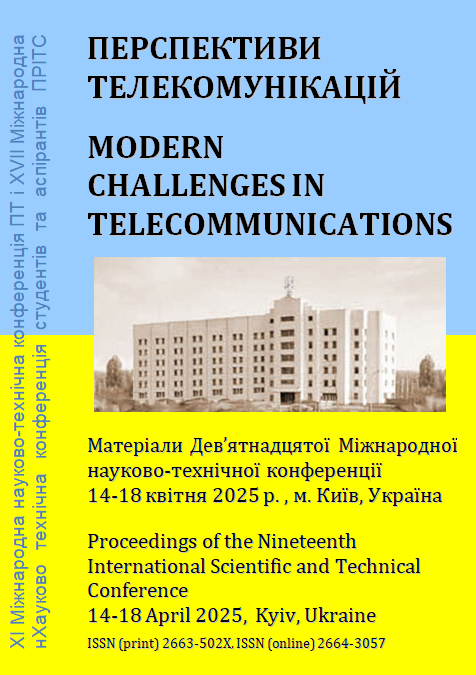МЕТОД ПОКРАЩЕННЯ ЯКОСТІ ПЕРЕДАЧІ БЕЗПРОВІДНОГО СИГНАЛУ НА ЗБІЛЬШЕНУ ВІДСТАНЬ
Ключові слова:
оптичний потік, ретрансляція сигналу, стабілізація положенняАнотація
Запропоновано спосіб підвищення якості передачі бездротового сигналу за рахунок стабілізації положення передавального пристрою, заснований на розрахунку оптичного потоку відеокадрів з підстилаючою поверхнею. Цей метод можна застосовувати в різних сценаріях, таких як встановлення з’єднань з безпілотними літальними апаратами, керування автономними транспортними засобами та експлуатація промислових систем IoT. Забезпечуючи якісну передачу сигналу на великі відстані, навіть в умовах складного рельєфу поверхні та наявності радіоперешкод, запропонований спосіб показує високу ефективність.
Посилання
Horn, Berthold K.P.; Schunck, Brian G. (August 1981). Determining optical flow (PDF). Artificial Intelligence (англ.). 17 (1–3): 185—203. doi:10.1016/0004-3702(81)90024-2.
B. D. Lucas and T. Kanade (1981), An iterative image registration technique with an application to stereo vision. Proceedings of Imaging Understanding Workshop, pages 121—130.
Dosovitskiy, Alexey; Fischer, Philipp; Ilg, Eddy; Hausser, Philip; Hazirbas, Caner; Golkov, Vladimir; Smagt, Patrick van der; Cremers, Daniel; Brox, Thomas (2015). FlowNet: Learning Optical Flow with Convolutional Networks. 2015 IEEE International Conference on Computer Vision (ICCV). IEEE. pp. 2758–2766.
Alfarano, Andrea; Maiano, Luca; Papa, Lorenzo; Amerini, Irene (2024). "Estimating optical flow: A comprehensive review of the state of the art". Computer Vision and Image Understanding. 249: 104160. doi:10.1016/j.cviu.2024.104160.
##submission.downloads##
Опубліковано
Як цитувати
Номер
Розділ
Ліцензія

Ця робота ліцензується відповідно до Creative Commons Attribution 4.0 International License.
Authors who submit to this conference agree to the following terms:a) Authors retain copyright over their work, while allowing the conference to place this unpublished work under a Creative Commons Attribution License, which allows others to freely access, use, and share the work, with an acknowledgement of the work's authorship and its initial presentation at this conference.
b) Authors are able to waive the terms of the CC license and enter into separate, additional contractual arrangements for the non-exclusive distribution and subsequent publication of this work (e.g., publish a revised version in a journal, post it to an institutional repository or publish it in a book), with an acknowledgement of its initial presentation at this conference.
c) In addition, authors are encouraged to post and share their work online (e.g., in institutional repositories or on their website) at any point before and after the conference.

